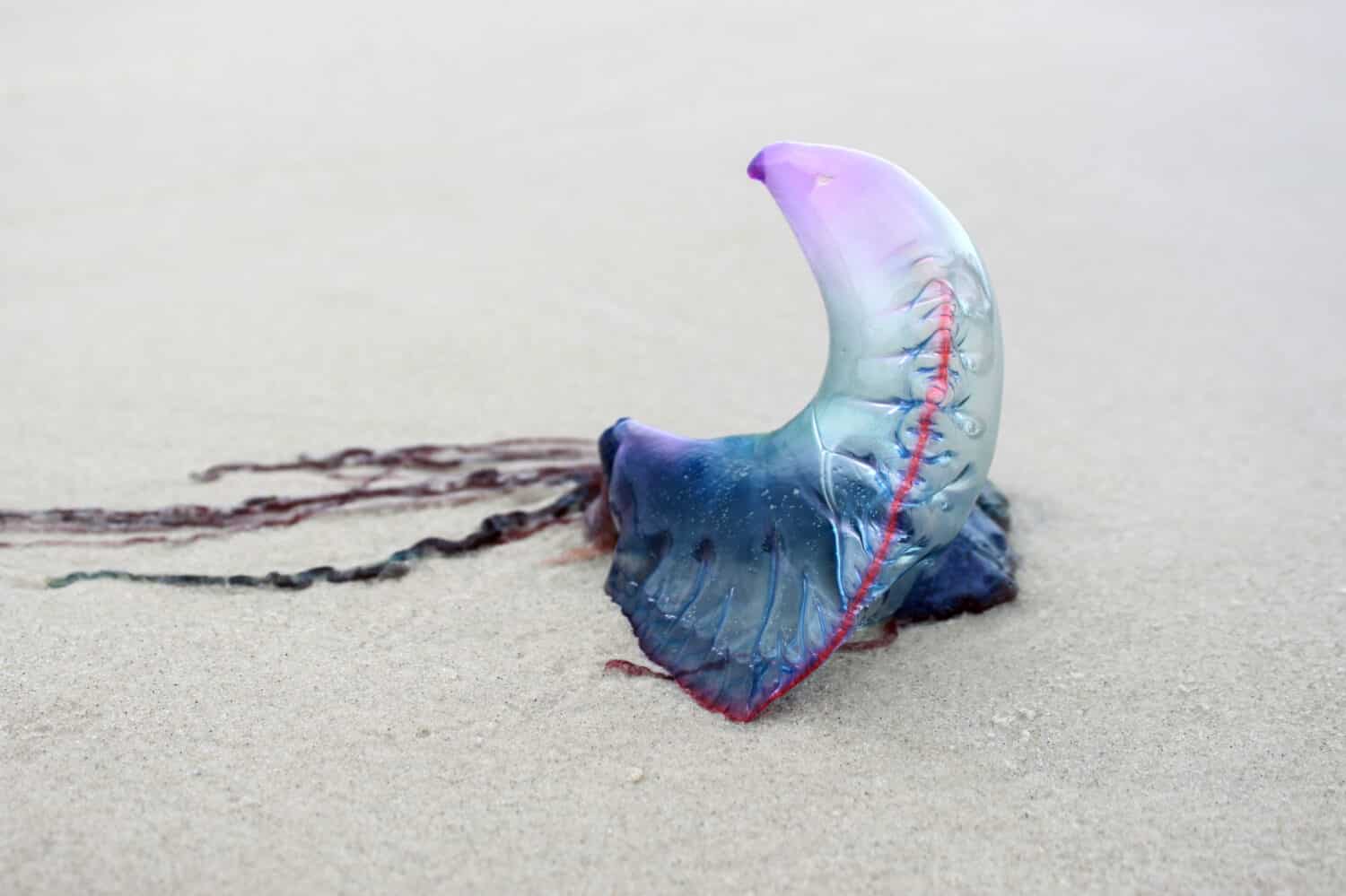Like any other body of water, the Atlantic Ocean can be home to dangerous animals. That includes some of the most dangerous animals in South Carolina’s oceans. However, it is essential to note that most marine life in the Atlantic Ocean poses no threat to humans. The ocean is a complex ecosystem with diverse species, each with its role and niche.
Some of the dangerous animals found in the Atlantic Ocean include sharks like the bull shark, great white shark, and tiger shark. While encounters with sharks are rare, exercising caution and respect when in their presence is essential. Other potentially dangerous creatures include venomous species like the Portuguese man o’ war, lionfish, and certain species of jellyfish.
However, it is crucial to maintain perspective. The ocean is not inherently dangerous but rather a natural environment where certain animals have evolved specific adaptations for survival. Awareness and knowledge of potential risks can help minimize any dangers associated with encounters with these animals.
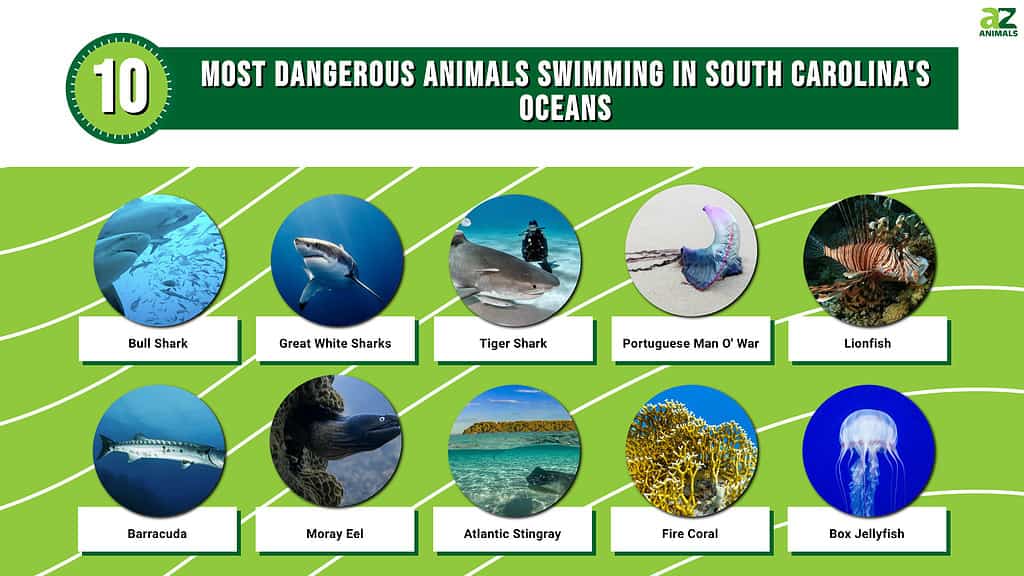
When enjoying the Atlantic Ocean, it is crucial to adhere to safety guidelines. That includes heeding warning signs, swimming in designated areas, and being aware of local conditions. Respect for marine life and their habitats is paramount. Maintaining a safe distance and not interfering with their natural behaviors can significantly reduce the risk of these uncommon incidents.
Ultimately, the Atlantic Ocean is a wondrous and dynamic ecosystem worthy of exploration and appreciation. By understanding potential risks and approaching marine life with respect, people can safely enjoy it while marveling at its beauty and diversity.
Let’s explore some of the most dangerous animals swimming in South Carolina’s Oceans.

The South Carolina coastline is home to a wide variety of marine animals.
©Nature’s Charm/Shutterstock.com
Bull Shark (Carcharhinus leucas)
The bull shark is a remarkable creature found in oceans worldwide. This species possesses distinct characteristics that make it both intriguing and potentially dangerous.
Bull sharks can reach lengths of up to 7 to 8 feet on average, with common reports of up to 11 feet, making them one of the larger coastal sharks. Their bodies are streamlined and muscular, allowing them to navigate through the water with ease swiftly.
In the coastal waters of South Carolina, bull sharks can be found nearshore, patrolling areas close to the coastline. They prefer warm and shallow waters around estuaries, bays, and river mouths.
Bull sharks possess several characteristics that can make them dangerous. Firstly, their size and strength enable them to overpower prey effectively. While hunting, they may mistake humans for potential food sources, such as fish or seals, and engage in exploratory bites. Secondly, bull sharks have a territorial nature, especially during mating or when protecting their young. Encroaching upon their territory or inadvertently provoking them can trigger defensive reactions. Additionally, the bull shark’s preference for coastal waters increases the likelihood of encountering them in areas frequented by humans for recreational activities, such as swimming or surfing.
While the bull shark’s reputation as a dangerous species precedes it, it is important to note that these sharks do not purposefully seek out confrontations with humans. Like other sharks, bull sharks are apex predators, equipped with sharp teeth designed to capture their prey efficiently. The danger lies in their potential interaction with humans due to their habitat preferences and feeding behaviors. Mistaken identity, territorial defense, or curiosity can contribute to human encounters.
It is crucial to approach encounters with bull sharks with caution and respect. Understanding their habits, avoiding areas where they are known to be present, and adhering to recommended safety guidelines can minimize the risk of incidents.

Bull sharks are common in the coastal waters of South Carolina.
©Martin Prochazkacz/Shutterstock.com
Great White Sharks (Carcharodon carcharias)
The great white shark is a majestic and powerful creature that resides in the coastal waters of every major ocean. This species possesses awe-inspiring characteristics and evokes a sense of both fascination and caution.
Great white sharks are known for their massive size and robust build. They can reach lengths of up to 11 to 16 feet on average and live as long as 70 years or more.
You can find great white sharks in the nearshore waters of South Carolina’s coastline. They inhabit areas close to the shore, including coastal reefs, sandbars, and even near estuaries where their prey is abundant.
The danger associated with great white sharks lies in their predatory nature and their incredible power. They sit at the top of the oceanic food chain. Their speed, agility, and acute senses make them efficient hunters. When hunting, they rely on a stealthy approach and bursts of speed to surprise and capture their prey.
While great white sharks do not purposefully target humans as prey, mistaken identity or curiosity can sometimes result in attacks. In certain situations, such as low visibility or when humans engage in activities resembling natural prey behavior, a shark may mistake a human for prey. The shark’s attack is usually investigative, and once it realizes its error, it typically disengages.
It is essential to understand that great white sharks play a crucial role in maintaining the balance of the marine ecosystem. While they can pose a potential danger, they are an integral part of the oceanic web of life. Respect for their habitats, adherence to safety guidelines, and promoting conservation efforts are key to coexisting safely with these remarkable creatures.
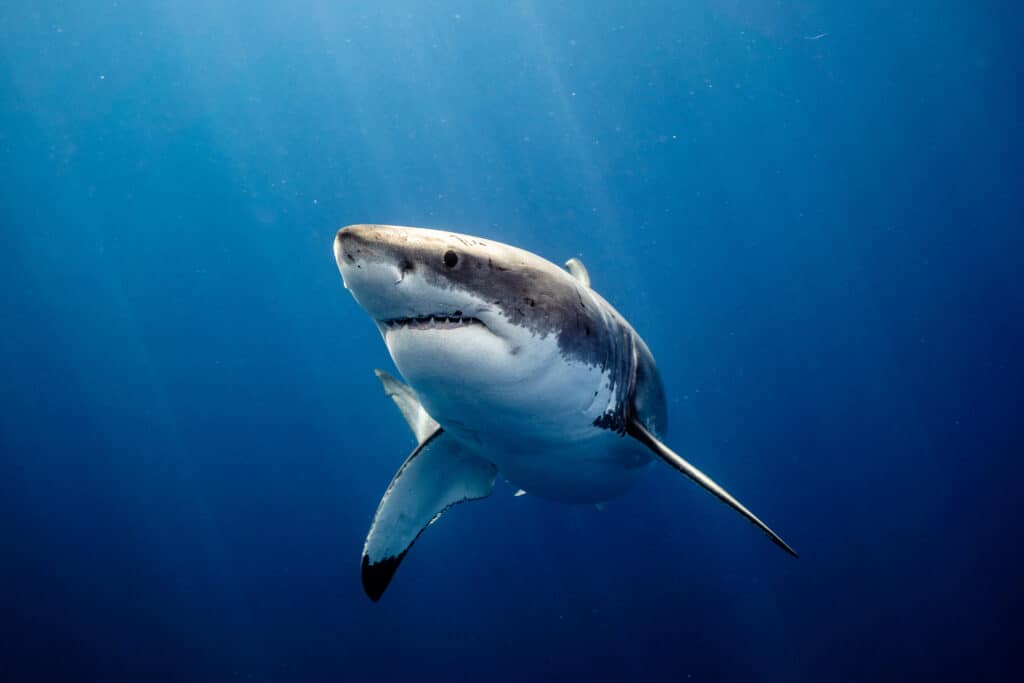
Great white sharks inhabit areas close to the shore, including coastal reefs, sandbars, and even near estuaries where their prey is abundant.
©Jsegalexplore/Shutterstock.com
Tiger Shark (Galeocerdo cuvier)
The tiger shark is an enigmatic creature that inhabits the coastal waters in tropical and temperate ocean waters. This unique species gets its name from its patterned skin, resembling tiger stripes.
Tiger sharks are known for their large size, reaching lengths of 10 to 13 feet, with reports of females reaching over 16 feet. They have stout bodies and distinctive, blunt snouts.
In the coastal waters of South Carolina, you can find tiger sharks in nearshore areas, including estuaries, reefs, and even offshore regions. They have a wide distribution in the Atlantic Ocean and are known to inhabit various coastal environments.
The danger associated with tiger sharks stems from their feeding behavior and their broad diet. These sharks are opportunistic predators, often referred to as “garbage cans of the sea” due to their ability to consume a wide range of prey. Their strong jaws and sharp teeth enable them to feed on anything from fish and turtles to dolphins and even carrion.
While tiger sharks do not purposefully seek out humans as prey, their feeding habits, and curiosity can sometimes lead to incidents. Like the other sharks we’ve covered thus far, mistaken identity or investigative behavior can result in a tiger shark engaging with humans. Their powerful bite and size can harm humans if such encounters occur.
Like all sharks, tiger sharks play an essential role in maintaining the health and balance of the ocean ecosystem. They are not inherently malicious or seeking to harm humans. Promoting conservation efforts, understanding their behavior, and exercising caution in their presence can help mitigate potential risks and foster coexistence between humans and these magnificent creatures.
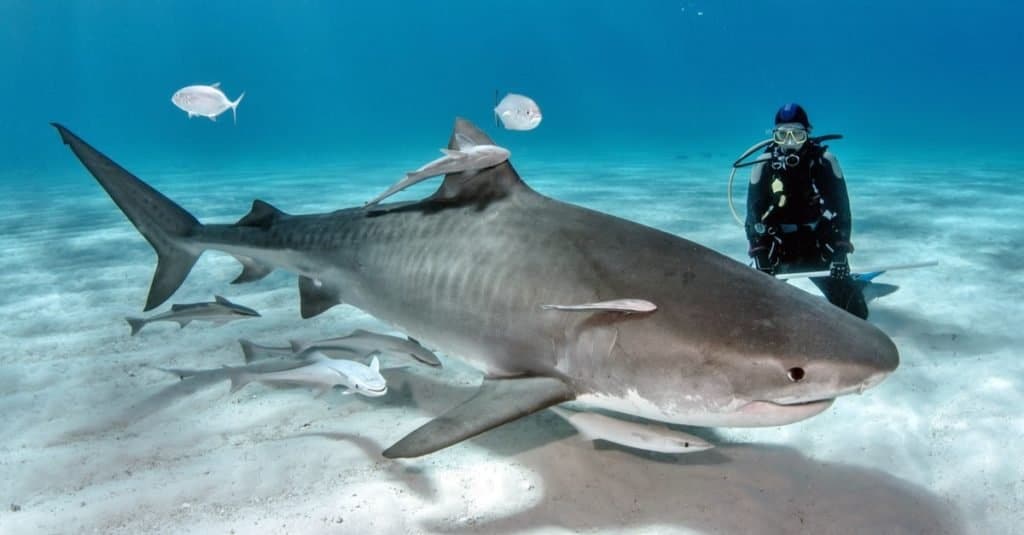
Tiger sharks are commonly referred to as “garbage cans of the sea” due to their habit of consuming a wide variety of prey.
©Tomas Kotouc/Shutterstock.com
Portuguese Man O’ War (Physalia physalis)
The Portuguese man o’ war is an interesting and potentially dangerous creature found in many oceans around the world. This fascinating marine organism is not a true jellyfish but a siphonophore, comprised of a colony of specialized polyps working together for survival.
The Portuguese man o’ war has a vibrant and distinctive appearance. It has a translucent, balloon-like float atop the water while long, trailing tentacles hang beneath it. These tentacles typically extend around 30 to 100 feet long, bearing numerous venomous cells called nematocysts.
In the coastal waters of South Carolina, the Portuguese man o’ war occupies drifting along the ocean’s surface, propelled by wind and currents. People can most commonly encounter them during the warmer months.
While the Portuguese man o’ war does not intentionally seek out human encounters, it can pose a danger due to its venomous tentacles. These tentacles possess nematocysts that deliver a potent sting. When humans come into contact with these tentacles, it can cause severe pain, inflammation, and in some cases, allergic reactions. The venom can affect the skin, nervous system, and cardiovascular system, posing a risk to individuals with allergies or sensitivities.
The Portuguese man o’ war’s stinging tentacles serves as a defense mechanism against potential threats. They are designed to immobilize and capture small fish and other prey. When inadvertently touched or approached by humans, the tentacles may release their venomous cells, resulting in a painful sting.
It is crucial to exercise caution and avoid direct contact with Portuguese man o’ war tentacles to minimize the risk of harm. If stung, seeking medical attention and following proper first aid procedures is important.

Coming into contact with the tentacles of Portuguese man o’ war can cause severe pain, inflammation, and in some cases, allergic reactions.
©Pedro Sales Prado/Shutterstock.com
Lionfish (Pterois volitans)
The lionfish is a striking and potentially hazardous creature. Originally native to the Indo-Pacific, this invasive species has established itself in the Atlantic Ocean, including the waters of South Carolina.
Lionfish have vibrant colorations and elaborate fin displays. They have striking red, brown, and white stripes along their bodies and long, flowing venomous spines on their dorsal, anal, and pelvic fins. These spines contain venom that serves as a defense mechanism against predators.
In the coastal waters of South Carolina, you can find lionfish in reef environments, including rocky outcrops, coral formations, and artificial structures like shipwrecks. People can encounter them in warmer months when water temperatures favor their survival.
The danger associated with lionfish lies in their venomous spines. If a human comes into contact with these spines, it can result in a painful sting. The venom can cause symptoms such as intense pain, swelling, nausea, and in rare cases, allergic reactions. Lionfish stings are a significant concern for divers, snorkelers, and anyone who comes into direct contact with them.
They are generally non-aggressive toward humans but use their venomous spines as a defense mechanism when threatened or cornered. Humans may inadvertently come into contact with the spines if they get too close to a lionfish or accidentally touch them.
Efforts are underway to manage the lionfish population and mitigate its impact on native marine life in the Atlantic Ocean. Promoting lionfish awareness, participating in removal programs, and supporting sustainable fishing practices can help control their numbers and minimize potential dangers.
While lionfish pose a potential danger to humans, it is crucial to approach encounters with caution and respect. Appreciating their beauty from a safe distance and avoiding direct contact with their venomous spines is key to coexisting safely with these intriguing creatures.

Lionfish have elaborate colorations of striking red, brown, and white stripes along their bodies.
©Greens and Blues/Shutterstock.com
Barracuda (Sphyraena genus)
The barracuda inhabits the tropical and subtropical oceans worldwide. With its sleek body and sharp teeth, the barracuda possesses distinct characteristics that make it both fascinating and a potential threat.
Barracudas have streamlined physiques and powerful jaws filled with razor-sharp teeth. They have a long, torpedo-shaped body and a prominent lower jaw that extends beyond the upper jaw. This unique feature gives them a menacing appearance.
In the coastal waters of South Carolina, you can find barracudas nearshore, patrolling areas close to the coastline. They prefer warm waters; people can find them in coral reefs, rocky areas, and seagrass beds.
The danger associated with barracudas lies in their predatory behavior and swift movements. Although they generally avoid human interactions, certain factors can trigger their strong predatory instincts. Barracudas are known to be attracted to shiny objects resembling small fish scales, which they consider prey. This attraction can result in the fish mistaking reflective jewelry or other metallic items for potential prey.
Additionally, barracudas can exhibit aggression when they feel threatened or when their territory is encroached upon. This behavior can lead to defensive bites if they perceive a potential threat.
If provoked, they respond to instinctual triggers that evoke predatory behavior. To minimize human encounters with barracudas, one can avoid wearing shiny objects in the water and respect their space in their natural habitat.
While barracudas have the potential to be dangerous, it is crucial to approach encounters with caution and always with respect. Appreciating their beauty from a safe distance and understanding their behaviors can help ensure safe coexistence with these impressive animals.
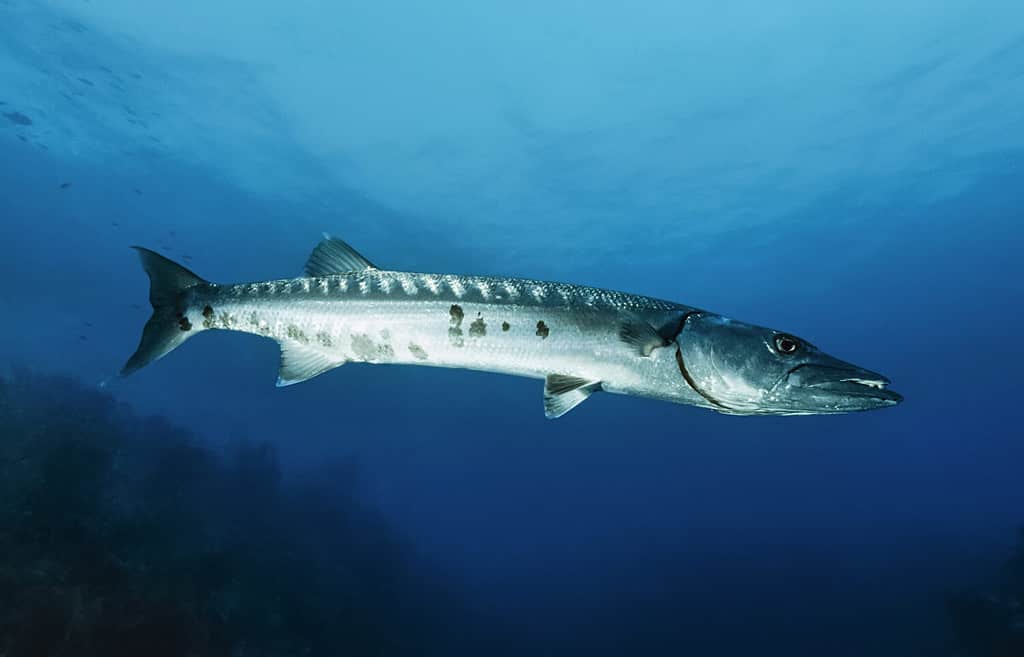
Barracuda are attracted to shiny objects because they closely resemble small fish scales.
©Angelo Giampiccolo/Shutterstock.com
Moray Eel (Muraenidae family)
The moray eel inhabits ocean waters worldwide, while a few species inhabit freshwater. With its unique physical attributes and hunting behaviors, the moray eel possesses distinct characteristics that make it potentially harmful.
Moray eels have elongated, snake-like bodies and powerful jaws filled with rows of sharp teeth. Their muscular physique allows them to maneuver through crevices and coral reefs easily. Their skin is scaleless and often covered in mucus, which gives them a slimy appearance.
In the Atlantic Ocean coastal waters of South Carolina, you can find moray eels inhabiting coral reefs, rocky areas, and crevices. They prefer warm waters, and people can encounter them in areas with abundant prey. You can even view moray eels at the South Carolina Aquarium.
The danger associated with moray eels lies in their defensive nature and ability to deliver powerful bites. Moray eels have poor eyesight, relying primarily on their sense of smell to locate prey. Suppose a diver or snorkeler inadvertently approaches too closely, accidentally touches, or threatens the eel by invading its hiding place. In that case, it may interpret this as a threat and attack defensively. Their bites can cause significant wounds due to their strong jaws and backward-facing teeth.
They typically prefer to avoid human interactions and will only bite in self-defense when they feel threatened or cornered. Maintaining a respectful distance and refraining from provoking or disturbing them can significantly minimize the likelihood of an encounter and subsequent defensive bite.

There are many species of moray eel.
©Didier Barriere Doleac/Shutterstock.com
Atlantic Stingray (Dasyatis sabina)
The Atlantic stingray resides in the Atlantic Ocean’s coastal waters. It has unique physical features and defensive mechanisms.
Atlantic stingrays have a flat body shape, resembling a round disc with a long, whip-like tail. They typically have a dark brown or grayish upper surface with a pale underside. They possess rough skin covering their bodies instead of scales. The stingray’s most prominent feature is its venomous spine, located near the base of its tail.
Atlantic stingrays inhabit sandy or muddy environments off the coastline of South Carolina. People can encounter them in shallow waters, including estuaries, bays, and nearshore areas.
The danger associated with Atlantic stingrays lies in their venomous spine. When threatened or accidentally stepped on, the stingray can flex its tail, driving the spine into the attacker. The venom injected through the spine can cause intense pain, swelling, and other symptoms.
It is important to note that Atlantic stingrays do not attack on purpose. They use their venomous spine as a defense mechanism to protect themselves from potential threats. When approached too closely or inadvertently disturbed, the stingray may feel threatened and react defensively by deploying its spine.
Shuffling or sliding your feet along the seafloor is crucial when wading in shallow waters to minimize the risk of encountering a stingray’s defensive strike. This action alerts the stingrays of your presence, allowing them the opportunity to swim away without feeling threatened.

Atlantic stingrays inhabit the Atlantic Ocean.
©iStock.com/Rob Atherton
Fire Coral (Millepora genus)
Fire coral is a unique marine organism in tropical and subtropical ocean waters. Though often mistaken for true coral, rather, it is a hydrocoral more closely related to hydrozoan. A hydrozoan is a colonial organism consisting of numerous small, venomous polyps working together.
Fire coral colonies form crusty or branching structures and can display colors ranging from brown and yellow to green. They have tiny, stinging tentacles called nematocysts covering their surface, which contain venomous cells capable of delivering a painful sting.
In the coastal waters of South Carolina, you can find fire coral in shallow reef environments, attaching themselves to hard substrates like rocks, coral, or shipwrecks. They thrive in warm waters, and people can most commonly encounter them in the summer months.
The danger associated with fire coral lies in its venomous stinging cells. When someone touches or brushes against the nematocysts, it triggers the release of venom into the victim’s skin. This venom can cause intense pain, swelling, itching, and in some cases, allergic reactions or systemic effects.
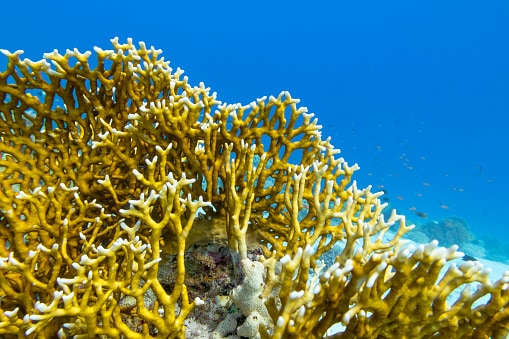
Fire coral can cause a burning sensation on human skin.
©mychadre77/iStock via Getty Images
Concerning human encounters, it uses its venomous stinging cells as a defensive mechanism to protect itself from potential threats. When someone inadvertently touches or approaches fire coral too closely, it activates the nematocysts, which deliver a sting to deter the perceived threat.

South Carolina’s coast is a hotspot for beachgoers.
©iStock.com/pabradyphoto
Box Jellyfish (Cubozoa class)
The box jellyfish inhabit oceans around the world in tropical and subtropical waters. With its unique physical characteristics and potent venom, the box jellyfish possesses distinct traits that make it a potential danger.
Box jellyfish have a distinct box-shaped bell with tentacles located at each corner. They are transparent or pale blue, allowing them to blend seamlessly with their surroundings. Their tentacles contain thousands of venomous cells called nematocysts, which they use for defense and capturing prey.
In the Atlantic Ocean, specifically off the coast of South Carolina, box jellyfish are not commonly found. While encountering some jellyfish species is common in this region, sightings of true box jellyfish are rare but can occur. It is always important to be aware of their potential presence, especially during periods of warm water temperatures.
The danger associated with box jellyfish lies in their venomous stings. The venom contains toxins that can cause intense pain, inflammation, and cardiovascular and neurological complications in severe cases. Box jellyfish stings can be life-threatening, mainly if they occur in sensitive areas of the body or if the victim has an allergic reaction.
They are not aggressive creatures but will defensively use their venomous tentacles if they feel threatened or if there is contact with their tentacles. Box jellyfish have well-developed visual systems that allow them to detect and avoid potential threats. However, due to their near transparency and the fact that they float near the water’s surface, accidental contact can occur, leading to a defensive response.
It is vital to adhere to safety precautions to minimize the risk of encountering box jellyfish or other jellyfish species. That includes paying attention to warning signs, wearing protective clothing like rash guards, and using appropriate protective measures such as wearing vinegar or using specialized jellyfish protective barriers when swimming in areas known to have jellyfish populations.

Box jellyfish are incredibly dangerous to humans due to their venomous stings.
©Danza/Shutterstock.com
Conclusion
In conclusion, the most dangerous animals swimming in South Carolina’s oceans are equally fascinating and potentially dangerous marine creatures. While encountering these animals can be a thrilling experience, it is crucial to understand the potential risks and exercise caution when interacting with them.
It is important to approach encounters with these animals responsibly and respect their habitats. Understanding their behavior, adhering to safety guidelines, and promoting conservation efforts are essential for coexisting safely with these remarkable creatures.
Summary of the 10 Most Dangerous Animals Swimming in South Carolina’s Oceans
| Rank | Animal | Scientific Name |
|---|---|---|
| 1 | Bull Shark | Carcharhinus leucas |
| 2 | Great White Sharks | Carcharodon carcharias |
| 3 | Tiger Shark | Galeocerdo cuvier |
| 4 | Portuguese Man O’ War | Physalia physalis |
| 5 | Lionfish | Pterois volitans |
| 6 | Barracuda | Sphyraena genus |
| 7 | Moray Eel | Muraenidae family |
| 8 | Atlantic Stingray | Dasyatis sabina |
| 9 | Fire Coral | Millepora genus |
| 10 | Box Jellyfish | Cubozoa class |
Thank you for reading! Have some feedback for us? Contact the AZ Animals editorial team.

